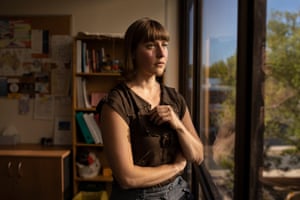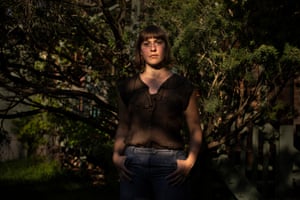Extract from The Guardian

The lawyer: Sophie Trevitt heard horrifying stories from youngsters in Alice Springs: ‘I have never seen a child enter a youth detention centre and come out better’
In March 2018 Sophie Trevitt was in her office, working as a civil lawyer in Alice Springs, when a colleague – a youth criminal lawyer – came to her with a case: two children who said “they had been really brutally treated by police.”
Trevitt drove around town looking for them, until she found five boys, all Indigenous, aged between 12 and 16.
“They were all really small kids,” Trevitt says. “One of the kids particularly stood out to me because my hand fit around his upper arm, he was that slight.”
One by one they told her the same story.
They were in a stolen car being chased by police. Mid-pursuit, they ran over spikes laid on the road to stop them and came to a halt. What happened next was not captured by police body cameras – they were not turned on.
The kids told Trevitt that police officers smashed the car windows and began to pull them out, some through the broken glass, some through the doors.
They said they were made to lie face down on the ground. Some of them alleged that a police officer walked on the back of their legs.
The kids told Trevitt they were then handcuffed and thrown into the back of a police van, where the officers began hurling racial taunts and threats, telling them they’d be dumped by the side of the road and that something bad was going to happen to them.
The NT ombudsman said it was “clear that substantial force was used in extricating the youths from the vehicles, and in their treatment after this.” A brief account of the incident was included in the ombudsman’s annual report in 2019.
Later that night, at the Alice Springs watch-house, CCTV footage obtained by the ABC shows one of the boys standing between two police officers at a table and being told to remove some of his clothing. The boy mutters: “Every day, bro. I’d smack you in the head every day.”
He continues: “Every day? Today’s your day, you little cunt. Don’t fucking put off for tomorrow what you can do today. You can’t fucking do it, can you, because you’re a little cunt. That’s all you are … fucking waste of space.”
The officer then tells the group of boys he is “in the mood to lose his job” if they refuse to comply with his directions.
When the footage was broadcast by the ABC in December last year, following a lengthy battle under freedom of information legislation, NT police commissioner Jamie Chalker defended the officer involved. “Policing is an incredibly hard job,” Chalker said, adding he would not “throw anyone under the bus” over the incident. Chalker said he would not release the outcome of disciplinary proceedings against two of the officers after the ombudsman’s report, saying it would breach their privacy.
But Trevitt is critical of that response.
“Police are trained professionals who should be expected to do their jobs without assaulting, threatening or abusing Aboriginal kids,” she says.
For her, the case was a turning point. She realised “systemic reform” was needed across the broader NT justice system, to ensure the safety of Indigenous kids.

Trevitt spoke to children who told her they were only getting an education 50% of the time. One missed his family so much he said he wanted to harm himself and had contemplated suicide. Others said they were kept in hot, noisy concrete rooms with five or six others, kept awake by the sounds of crying and banging on doors.
“I have never seen a child enter a youth detention centre and come out better,” Trevitt says. “What I have seen is children who didn’t appear to have mental health issues before they entered the youth detention centre come out … extremely traumatised.”
She also believes that some kids were being sent to detention unnecessarily.
She saw one client, who was just 13, regularly thrown in youth detention, without ever being convicted of a crime. According to Trevitt, each time the boy was brought to court, usually for alleged property offences, the court would decide he did not have the cognitive capacity to be held criminally responsible. Despite this, Trevitt claims, the child was arrested time and time again, and held in detention on remand, only to be released when his court date arrived.
“So this kid spent a year of his life behind bars that he never ever should have,” Trevitt says. “And I can’t describe the amount of harm that has done to that young person.”
The NT government told Guardian Australia it has invested $22m to redevelop the Alice Springs youth justice centre, including facilities to support rehabilitation programs, a cultural support program and a new dedicated medical and health facility, due in mid 2021.
In mid 2019 Sophie left the NT, determined to pursue broader changes to the Australian justice system. She’s now living in Canberra and is campaigning to raise the age of criminal responsibility, to keep very young kids out of this system.

The UN committee on the rights of the child has called on countries to raise the age to 14 – the median age worldwide – with countries like China and Russia heeding that call. Australia sets the bar at 10.
In Australia, the push to “raise the age” has been spearheaded by the National Aboriginal and Torres Strait Islander Legal Service, with organisations including the Australian Indigenous Doctors’ Association, the Australian Medical Association, and the Law Council of Australia adding their voice to this campaign. They argue: “Children under the age of 14 are undergoing significant growth and development, meaning they may not have the required capacity to be criminally responsible.”
They also argue that “communities and society will not be safer or healthier if children are in prison”.
Trevitt agrees: “We know that any contact a child has with the criminal justice system increases their chance of having future contact.”
In late 2019, the Australian Capital Territory became the first Australian jurisdiction to commit to raising the age to 14.
But at a meeting in early 2020, the Council of Attorneys-General decided there was still work to do on what would replace the current system.
“When governments say we need to wait for more solutions, actually what they’re saying is we’re choosing to invest in hurting that kid and making the community less safe in the meantime, and I just don’t think that that’s acceptable,” Trevitt says.

No comments:
Post a Comment